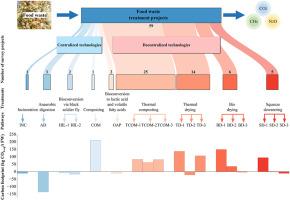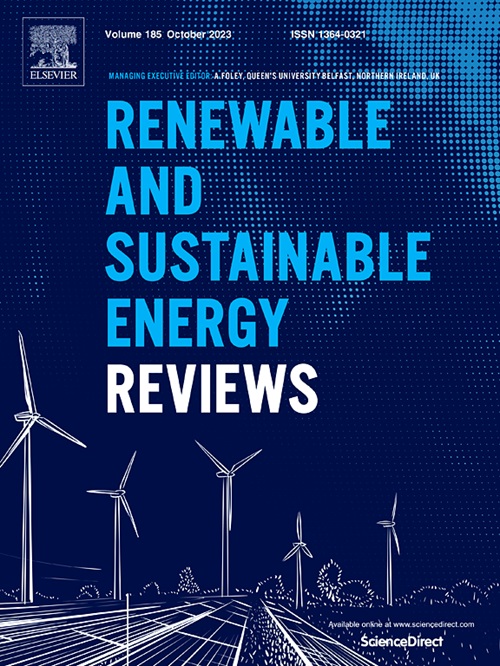集中式和分散式厨余利用途径的碳足迹
IF 16.3
1区 工程技术
Q1 ENERGY & FUELS
引用次数: 0
摘要
餐厨垃圾通常由集中式处理设施处理,有时也由分散式处理设施处理,但后者的碳排放量尚未得到系统评估。本研究调查了深圳市 59 个集中式和分散式餐厨垃圾处理项目,应用了焚烧、厌氧消化、堆肥以及昆虫生物转化和有机酸生产等新兴技术。根据收集和运输、能源和材料消耗、二次污染物控制和杂质处理等方面的真实数据,对它们的碳足迹进行了分析。结果表明,集中式设施的总体碳足迹较低,但其收集和运输过程中的碳排放量较高。厌氧消化的表现最好,平均碳排放量为-136.63 千克二氧化碳当量/吨,其次是黑兵蝇幼虫养殖(-12.86 千克二氧化碳当量/吨)、焚烧(-11.02 千克二氧化碳当量/吨)和有机酸生产(-6.86 千克二氧化碳当量/吨)。所有分散式设施在运行时都有净碳排放,因为它们消耗了大量电力或热能,却没有充分利用厨余垃圾中的有机物。通过将集中式厌氧消化和分散式挤压脱水与充分的油回收相结合,推荐了一条最佳路线,这可使总体碳排放量从-6.72 千克二氧化碳当量/吨降至-17.75 千克二氧化碳当量/吨。这些结果可为决策者提供餐厨垃圾管理方面的指导,以支持净零排放和可持续发展目标 12 和 13。本文章由计算机程序翻译,如有差异,请以英文原文为准。

Carbon footprints of centralized and decentralized food waste utilization pathways
Food waste is usually utilized in centralized treatment facilities and is sometimes treated in decentralized facilities; however, the latter has not been evaluated systematically regarding carbon emissions. This study surveyed fifty-nine centralized and decentralized food waste treatment projects in Shenzhen, and incineration, anaerobic digestion, composting, and emerging technologies such as insect bioconversion and organic acid production were applied. Their carbon footprints were analyzed based on real data covering collection and transport, energy and material consumption, secondary pollutant control, and impurity disposal. The results showed that centralized facilities had a lower overall carbon footprint, although carbon emissions from their collection and transportation were higher. Anaerobic digestion performed best with an average carbon emission of −136.63 kg CO2-eq/t, followed by black soldier fly larvae cultivation (−12.86 kg CO2-eq/t), incineration (−11.02 kg CO2-eq/t), and organic acid production (−6.86 kg CO2-eq/t). All decentralized facilities were operated with net carbon emissions because they consumed a large amount of electricity or thermal heat without the full use of organic matter in the food waste. An optimal route was recommended by combining centralized anaerobic digestion and decentralized squeezing dewatering with adequate oil recovery, and this can make the overall carbon emission decrease from −6.72 kg CO2-eq/t to −17.75 kg CO2-eq/t. These results can provide decision-makers with guidance on food waste management to support net zero and sustainable development goal 12 and 13.
求助全文
通过发布文献求助,成功后即可免费获取论文全文。
去求助
来源期刊

Renewable and Sustainable Energy Reviews
工程技术-能源与燃料
CiteScore
31.20
自引率
5.70%
发文量
1055
审稿时长
62 days
期刊介绍:
The mission of Renewable and Sustainable Energy Reviews is to disseminate the most compelling and pertinent critical insights in renewable and sustainable energy, fostering collaboration among the research community, private sector, and policy and decision makers. The journal aims to exchange challenges, solutions, innovative concepts, and technologies, contributing to sustainable development, the transition to a low-carbon future, and the attainment of emissions targets outlined by the United Nations Framework Convention on Climate Change.
Renewable and Sustainable Energy Reviews publishes a diverse range of content, including review papers, original research, case studies, and analyses of new technologies, all featuring a substantial review component such as critique, comparison, or analysis. Introducing a distinctive paper type, Expert Insights, the journal presents commissioned mini-reviews authored by field leaders, addressing topics of significant interest. Case studies undergo consideration only if they showcase the work's applicability to other regions or contribute valuable insights to the broader field of renewable and sustainable energy. Notably, a bibliographic or literature review lacking critical analysis is deemed unsuitable for publication.
 求助内容:
求助内容: 应助结果提醒方式:
应助结果提醒方式:


